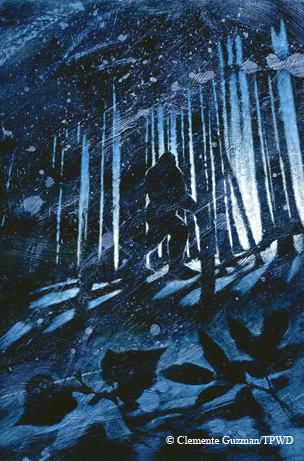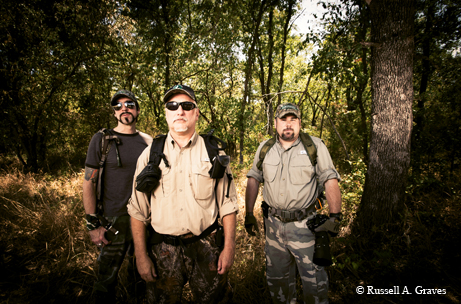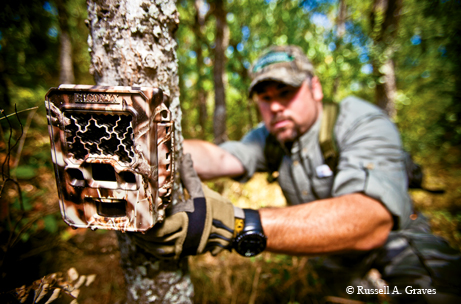Texas Bigfoot hunters are on a mission to catch a glimpse of the legendary beast.
I can remember it as if it were yesterday, though I was only a boy. Eyes glued to the screen, hardly breathing, pulse pounding, I watched for a glimpse of a beast in those woods that looked so much like my own. No doubt about it, The Legend of Boggy Creek made an indelible mark on me.
The campy, early 1970s documentary-style film was set in the backwoods and bottomlands of Fouke, Ark. As the crow flies, Fouke was only about 130 miles from my home, and we shared the same Red River watershed. At the ripe old age of 8, I thought it seemed quite plausible that Bigfoot lived in Fannin County, maybe in the hardwoods I explored with my friends.

My dad would take us down to the creek bottoms in the dark of night and thrill us with wild tales of the Bois d’Arc Creek monster. His spotlight would catch a pair of glowing eyes in the woods, and he’d delight in telling us that those eerie orbs probably belonged to none other than Bigfoot.
Legend, myth, hoax or reality — call it what you will, but the story of Bigfoot has mystified us for generations.
In the northwestern United States, where the legend came of age, indigenous populations are peppered with legendary stories of Bigfoot. Each culture developed its own nuances about the traits of the mysterious creature. For example, in Texas, Bigfoot is also known as Southern Sasquatch.
Outside the Pacific Northwest, Texas is considered one of the hotbeds of Bigfoot activity with numerous reported sightings over the past six decades. Predictably, because of the forest density and the numerous waterways, the wedge of Texas between the Louisiana border and Interstate 45 from Houston to Dallas has the highest incidence of Bigfoot reports. Most sightings have been roadside encounters. Reports continue to filter in.
With a dearth of scientifically verifiable evidence, many people don’t believe in the existence of Bigfoot. Critics say that anecdotal eyewitness accounts are unreliable and that the chance of such a large animal living undetected is unlikely.
On the other hand, cryptozoologists (scientists who study not-yet-verified animals) believe in the presence of undocumented animals despite the lack of hard evidence. Some point to species like the giant squid and the mountain gorilla as examples of species once thought legendary yet are now part of the scientific record.

For members of the Texas Bigfoot Research Conservancy (TBRC), the quest is for the truth.
“While growing up, I was always interested in any shows about the outdoors or wildlife, but I was always greatly intrigued by the idea of undiscovered species,” says Chris Buntenbah, TBRC member and frequent research expedition participant. A professional videographer and photographer, Buntenbah parlays this fascination to assist the group with his particular skill set. In 2006 he headed up TBRC’s most ambitious research project to date: Operation Forest Vigil.
Operation Forest Vigil is a five-year project to capture photographic proof of the Sasquatch in East Texas, as well as the Ouachita Mountains of Arkansas and Oklahoma. TBRC has invested tens of thousands of dollars in rapid-fire remote wildlife cameras. The results, so far, have yielded no evidence of the Southern Sasquatch. Buntenbah points out that a known species in the area — the mountain lion — has also never been captured on camera.

“We have a very compelling piece of evidence in a dread of hair found by a hunter in East Texas that has come back [from the lab] as ‘nonhuman primate.’ We are also testing some evidence that could be a game-changer,” he says.
Buntenbah isn’t alone in his fascination with the unknown. TBRC (originally formed in 2001 as the Texas Bigfoot Research Center) is a federally recognized nonprofit group made up of volunteer investigators, naturalists and scientists from all over Texas and Oklahoma. The TBRC mission is, in part, to conduct research and investigate the existence of primate species in Texas, Oklahoma, Arkansas and Louisiana.
For Buntenbah and other members of the TBRC, the chance to explore the unknown is what draws them afield.
“I saw The Legend of Boggy Creek movie back in the 1970s, and I vowed to research the subject,” says Jerry Hestand, lifelong resident of Grayson County in North Texas and a fourth-grade math teacher in Bells. Hestand is a founding member of the group and helps organize its annual conference in early October in Tyler.
Like Buntenbah, Hestand heads out on research trips when reported sightings bear enough credibility to warrant the group’s time. He hasn’t always been a believer.
“I have seen two items of ‘hard evidence’ in the last two years,” he says. “I was somewhat of a skeptic until June of 2011. Then some evidence came forth that is compelling. I feel our group and another group of scientists are close to solving the mystery of this evidence with indisputable proof.”
During our day together, Hestand wouldn’t reveal the exact nature of the evidence other than to say that it’s “good.” Nevertheless, I couldn’t help but be intrigued.
We traipsed around together in the woods of north-central Fannin County, and I took them to a spot where I saw an unknown figure on a winter’s night back in 1986. My brother Bubba tells them of another mysterious encounter back in the ’80s just about a mile away. While we’ll never know exactly what we saw, we both know we saw something. After we relate our stories, Lyle Blackburn tells me of his experiences.
“I spent a lot of time as a kid hunting deer and turkey with my dad around the North Texas area,” he says. “Once I watched a show about Bigfoot and realized that there might be a real monster living close by in Arkansas, my imagination ran wild.” I was beginning to see a pattern here.
Blackburn is a creative type who lives in Bedford and spends his time as a Web/graphic designer, writer and rock musician. A newcomer to TBRC, he has been an active investigator for only two years, but he participates with zeal.
“I’ve read a lot books and watched documentaries on the subject over the years, but it wasn’t until about three or four years ago that I had time to look into the phenomenon more closely,” he says.
Blackburn is finishing up a book on the Fouke, Ark., legend.
“As an adult I have a more rational approach to the subject,” he says. “Nonetheless, I still feel that sense of childlike wonder when I’m out there in the dark woods at night trying to get my own glimpse of a legendary creature.”
Original source:
Graves, R. A. (2011). Sasquatch stalkers. Texas Parks & Wildlife Magazine online. Retrieved from here November 18, 2011.
Visit Russell A. Graves’s website.
Visit Russell A. Graves’s blogsite.
Note: The Texas Bigfoot Research Center was formed in 1999; the Texas Bigfoot Research Conservancy was incorporated as a nonprofit research organization in January 2007.
